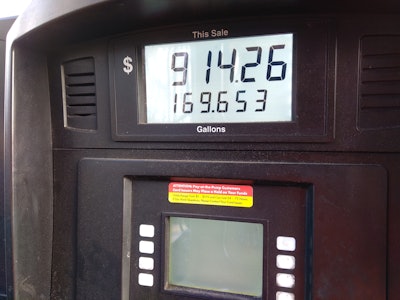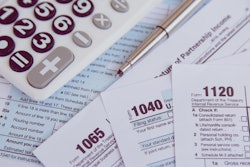Keeping track of all costs and their shares of revenue will help you see whether any part of your operation is abnormal compared to other owner-operators. This is useful not just for cost-cutting, but also for making business decisions.
 Fuel is an owner-operator's biggest annual expense. In 2022, when diesel prices averaged $5.01 a gallon nationwide, it accounted for nearly a third of operators' total revenue.
Fuel is an owner-operator's biggest annual expense. In 2022, when diesel prices averaged $5.01 a gallon nationwide, it accounted for nearly a third of operators' total revenue.
- Fuel: 32.5%
- Truck payment: 17.3%
- Maintenance: 6.5%
- Insurance: 4.3%, counting physical damage, bobtail and occupational accident premiums
- License and permits: 1.8%
- Cell phones and other communications: 0.8%
Of course, these numbers will be different for everyone, and fuel costs for 2023 are likely to account for a bit lower percentage than these 2022 numbers. However, based on 2022 averages, the average ATBS client nets 36.5 cents for every dollar of gross revenue, meaning 63 cents of every dollar earned has to go toward expenses. Keep that in mind the next time you’re tempted to go on a spending spree with a big settlement check, as rare as those may be these days.
On the other hand, if (before you account for your own pay) you’re netting much less than a third of your revenue overall, take a careful look at your records. Chances are one or two costs are out of control, or your revenue is too low for long-term sustainability.

[Related: If your trucking income's taken a beating this down cycle, you're not alone]
You can easily track your expenses with a profit-and-loss statement. All your records should be accumulated throughout the month and turned into a profit-and-loss statement, also called a financial statement or a statement of earnings. Gather your settlement statements and receipts into like categories, and total them up at the end of each month. Then incorporate your operating information in a consistent format to make the profit-and-loss statement.
The statement should tell you how many miles you drove, your revenue, your costs and how much money you made during the month -- your profit or loss.
Building a monthly P&L allows you to track progress month to month to see if you are improving. The statement should include ratios such as cents per mile and percent of revenue so you can analyze your performance.
Successful owner-operators have to know how to adjust for changing conditions. If you don’t, profitability probably will decline. Are fuel prices low or high? What about insurance costs? Is the economy growing? What do industry analysts say about conditions in the months ahead? Make it part of your routine to compare your P&L report with your budget and figure out changes you need to make to maximize profitability.
[Related: How owner-operators can avoid joining the 'capacity reduction' ranks]
Owners looking for additional money- and other management tips, among a myriad of other topics, can find more in the Overdrive/ATBS-coproduced "Partners in Business" manual for new and established owner-operators, a comprehensive guide to running a small trucking business. Click here to download the updated 2023 edition of the Partners in Business manual free of charge.









